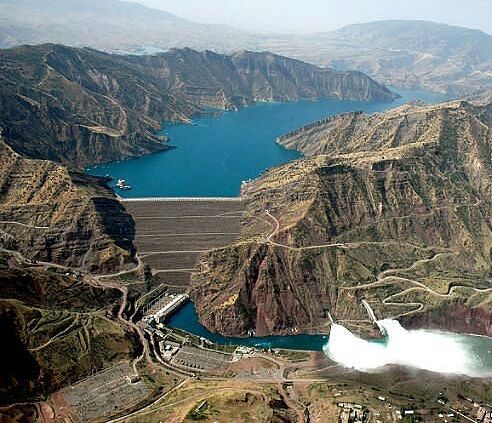Restoring Hydropower in Remote Regions of Tajikistan
Published on by Water Network Research, Official research team of The Water Network in Government
Pamir Energy, the first ever public-private partnership in Tajikistan, was honoured at the 2017 Ashden Awards for restoring Soviet-era hydro plants in order to bring electricity to the 254,000 people living in the most remote areas of Tajikistan and Afghanistan.

Nurek Dam Tajikistan, Image source: Wikimedia Commons, Author: Troetona
Bordering Afghanistan, Viloyati Mukhtori Kuhistoni Badakhshon (VMKB) is a remote, mountainous, rural area in the Pamir Mountains of eastern Tajikistan where winter temperatures can fall to a stark -30°C.
For the local community living in this already unforgiving environment, life became even harder after the collapse of the Soviet Union in 1991, when much of the region’s electricity supply was cut due to the destruction of the transmission infrastructure during the five-year-long civil war, and withdrawal of fuel subsidies for generators.
As such, locals have lived without access to reliable and affordable electricity since the early ‘90s. The lack of electricity for heating had major social impacts; schools, health centres and businesses closed and people were forced to rely on dangerous kerosene, coal, dung and firewood to light, heat and cook in their homes. These fuels have had a high environmental cost too, with around 70% of the region’s forests being destroyed in the decade following the war.
In 2002, the Government of Tajikistan decided to re-electrify the region, but it knew it couldn’t tackle the problem alone.
Public-private partnership
To tackle the problem Pamir Energy was born – the first ever public-private partnership in Tajikistan was formed by the coming together of The Aga Khan Fund for Economic Development (AKFED) and the International Finance Corporation.
The new business would use government will as well as corporate knowledge and efficiency to repower the region by reviving 11 abandoned hydropower plants and upgrading 4,300km of old transmission and distribution facilities. Today the company brings clean, affordable and sustainable energy to 96% of the population in this remote region, totalling around 254,000 people, including parts of neighbouring Afghanistan.
"Today the company brings clean, affordable and sustainable energy to 96% of the population in this remote region, totalling around 254,000 people."
Government and private sector collaboration has been challenging, according to general director of Pamir Energy, Daler Jumaev, who says the company relied on local insight and building on local capacity to bring electricity to the area.
“We are working in very hard climates, in remote areas where there are issues with transportation and logistics and different types of natural hazards and very low human development factors, especially in Afghanistan,” explains Jumaev.
Through the Pamir Energy project, the Tajikistan Government effectively handed over local infrastructure to the company, which, in turn, attracted private direct investment.
The initial investment for the project was $26m, but today is $53m, says Jumaev, who is also an electrical engineer and was previously a consultant before heading up Pamir Energy for the last ten years.
“We understand we are a little bit different from normal private sector companies, our shareholders are fond of economic development in very challenging areas,” he says. “We bring the financial discipline of the commercial sector but we are very socially minded, so whatever revenue we make we reinvest it into the ageing assets.”
Read full article: Power Technology
Media
Taxonomy
- Public Private Partnerships in Water
- Governance
- Governance & Policy
- Hydropower
- Infrastructure
- Dams
- Public Private Partnerships